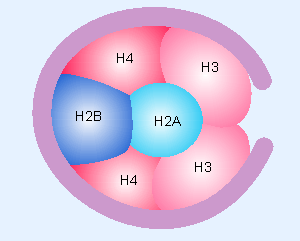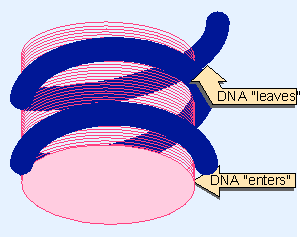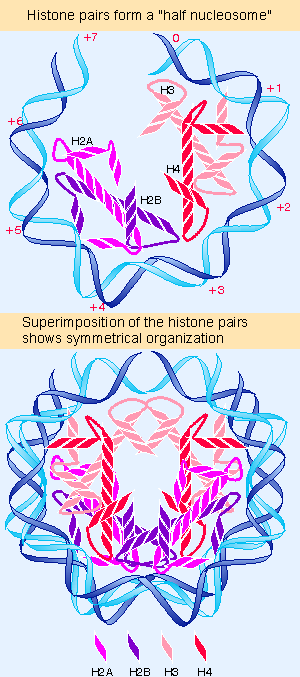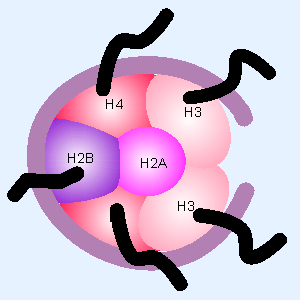7. Organization of the histone octamer
19.7 Organization of the histone octamer |
So far we have considered the construction of the nucleosome from the perspective of how the DNA is organized on the surface. From the perspective of protein, we need to know how the histones interact with each other and with DNA. Do histones react properly only in the presence of DNA, or do they possess an independent ability to form octamers? Most of the evidence about histone-histone interactions is provided by their abilities to form stable complexes, and by crosslinking experiments with the nucleosome.
The core histones form two types of complexes. H3 and H4 form a tetramer (H32 PH42). Various complexes are formed by H2A and H2B, in particular a dimer (H2A PH2B).
Intact histone octamers can be obtained either by extraction from chromatin or (with more difficulty) by letting histones associate in vitro under conditions of high-salt and high-protein concentration. The octamer can dissociate to generate a hexamer of histones that has lost an H2A PH2B dimer. Then the other H2A PH2B dimer is lost separately, leaving the H32 PH42 tetramer. This argues for a form of organization in which the nucleosome has a central "kernel" consisting of the H32 PH42 tetramer. The tetramer can organize DNA in vitro into particles that display some of the properties of the core particle.
 |
Figure 19.21 In a symmetrical model for the nucleosome, the H32- H42 tetramer provides a kernel for the shape. One H2A-H2B dimer can be seen in the top view; the other is underneath. |
Crosslinking studies extend these relationships to show which pairs of histones lie near each other in the nucleosome. (A difficulty with such data is that usually only a small proportion of the proteins becomes crosslinked, so it is necessary to be cautious in deciding whether the results typify the major interactions.) From these data, a model has been constructed for the organization of the nucleosome. It is shown in diagrammatic form in Figure 19.21.
Structural studies show that the overall shape of the isolated histone octamer is similar to that of the core particle. This suggests that the histone-histone interactions establish the general structure. The positions of the individual histones have been assigned to regions of the octameric structure on the basis of their interaction behavior and response to crosslinking.
 |
Figure 19.22 The crystal structure of the histone core octamer is represented in a space-filling model with the H32-H42 tetramer shown in white and the H2A-H2B dimers shown in blue. Only one of the H2A-H2B dimers is visible in the top view, because the other is hidden underneath. The potential path of the DNA is shown in the top view as a narrow tube (one quarter the diameter of DNA), and in the side view by the parallel lines in a 20 Å wide bundle. Photographs kindly provided by Evangelos Moudrianakis. Multiple figure |
The crystal structure (at 3.1 Å resolution) suggests the model for the histone octamer shown in Figure 19.22. Tracing the paths of the individual polypeptide backbones in the crystal structure suggests that the histones are not organized as individual globular proteins, but that each is interdigitated with its partner, H3 with H4, and H2A with H2B. So the model distinguishes the H32 PH42 tetramer (white) from the H2A PH2B dimers (blue), but does not show individual histones.
 |
Figure 19.4 The nucleosome may be a cylinder with DNA organized into two turns around the surface. |
The top view represents the same perspective that was illustrated schematically in Figure 19.21. The H32 PH42 tetramer accounts for the diameter of the octamer. It forms the shape of a horseshoe. The H2A PH2B pairs fit in as two dimers, but only one can be seen in this view. The side view represents the same perspective that was illustrated in Figure 19.4. Here the responsibilities of the H32 PH42 tetramer and of the separate H2A PH2B dimers can be distinguished. The protein forms a sort of spool, with a superhelical path that could correspond to the binding site for DNA, which would be wound in almost two full turns in a nucleosome. The model displays two fold symmetry about an axis that would run perpendicular through the side view (Arents et al., 1991).
 |
Figure 19.23 Histone positions in a top view show H3-H4 and H2A-H2B pairs in a half nucleosome; the symmetrical organization can be seen in the superimposition of both halves. Multiple figure |
A more detailed view of the positions of the histones (based on a crystal structure at 2.8Å) is summarized in Figure 19.23. The upper view shows the position of one histone of each type relative to one turn around the nucleosome (numbered from 0 to +7). All four core histones show a similar type of structure in which three α-helices are connected by two loops: this is called the histone fold. These regions interact to form crescent-shaped heterodimers; each heterodimer binds 2.5 turns of the DNA double helix (H2A-H2B binds at +3.5 V6; H3-H4 binds at +0.5 V3 for the circumference that is illustrated). Binding is mostly to the phosphodiester backbones (consistent with the need to package any DNA irrespective of sequence). The H32 PH42 tetramer is formed by interactions between the two H3 subunits, as can be seen in the lower part of the figure (Luger et al., 1997).
 |
Figure 19.24 The globular bodies of the histones are localized in the histone octamer of the core particle, but the locations of the N-terminal tails, which carry the sites for modification, are not known, and could be more flexible. |
Each of the core histones has a globular body that contributes to the central protein mass of the nucleosome. Each histone also has a flexible N-terminal tail, which has sites for modification that may be important in chromatin function. The positions of the tails, which account for about one quarter of the protein mass, are not so well defined, as indicated in Figure 19.24. However, the tails of both H3 and H2B can be seen to pass between the turns of the DNA superhelix and extend out of the nucleosome. The tail of H4 appears to contact an H2A-H2B dimer in an adjacent nucleosome; this could be an important feature in the overall structure.
 |
Figure 19.25 Acetylation of lysine or phosphorylation of serine reduces the overall positive charge of a protein. |
All of the histones are modified by covalently linking extra moieties to the free groups of certain amino acids. Acetylation and methylation occur on the free (ε ) amino group of lysine. As seen in Figure 19.25, this removes the positive charge that resides on the NH+3 form of the group. Methylation also occurs on arginine and histidine. Phosphorylation occurs on the hydroxyl group of serine and also on histidine. This introduces a negative charge in the form of the phosphate group.
These modifications are transient. Because they change the charge of the protein molecule, they are potentially able to change the functional properties of the octamers. Modification of histones is associated with structural changes that occur in chromatin at replication and transcription. Phosphorylations on specific positions and on different histones may be required for particular processes, for example, the Ser10 position of H3 is phosphorylated when chromosomes condense at mitosis.
In synchronized cells in culture, both the pre-existing and newly synthesized core histones appear to be acetylated and methylated during S phase (when DNA is replicated and the histones also are synthesized). During the cell cycle, the modifying groups are later removed.
The coincidence of modification and replication suggests that acetylation (and methylation) could be connected with nucleosome assembly. One speculation has been that the reduction of positive charges on histones might lower their affinity for DNA, allowing the reaction to be better controlled. The idea has lost some ground in view of the observation that nucleosomes can be reconstituted, at least in vitro, with unmodified histones.
A cycle of phosphorylation and dephosphorylation occurs with H1, but its timing is different from the modification cycle of the other histones. With cultured mammalian cells, one or two phosphate groups are introduced at S phase. But the major phosphorylation event is the later addition of more groups at mitosis, to bring the total number up to as many as six. All the phosphate groups are removed at the end of the process of division. The phosphorylation of H1 is catalyzed by the M-phase kinase that provides an essential trigger for mitosis (see 27 Cell cycle and growth regulation). In fact, this enzyme is now often assayed in terms of its H1 kinase activity. Not much is known about phosphatase(s) that remove the groups later.
The timing of the major H1 phosphorylation has prompted speculation that it is involved in mitotic condensation. However, in Tetrahymena (a protozoan) it is possible to delete all the genes for H1 without significantly affecting the overall properties of chromatin. There is a relatively small effect on the ability of chromatin to condense at mitosis. Some genes are activated and others are repressed by this change, suggesting that there alterations in local structure. Mutations that eliminate sites of phosphorylation in H1 have no effect, but mutations that mimic the effects of phosphorylation produce a phenotype that resembles the deletion. This suggests that the effect of phosphorylating H1 is to eliminate its effects on local chromatin structure.
| Research | |
| Arents, G., Burlingame, R. W., Wang, B.-C., Love, W. E., and Moudrianakis, E. N. (1991). The nucleosomal core histone octamer at 31 Å resolution: a tripartite protein assembly and a left-handed superhelix. Proc. Nat. Acad. Sci. USA 88, 10148-10152. | |
| Luger, K. et al. (1997). Crystal structure of the nucleosome core particle at 28 Å resolution. Nature 389, 251-260. | |